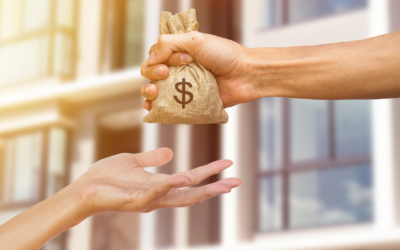What is a Good Cap Rate?
|
MAY 10, 2024
|
Introduction
Understanding the capitalization rate is crucial when analyzing real estate investments. But what defines a good cap rate for multifamily properties?
Real estate investors examining multifamily properties need to determine what constitutes a “favorable investment” or an “unfavorable investment.” A favorable investment typically means the property will offer attractive returns that are worth the risk, compared to other investment options.
This is where the ‘cap rate’ comes into play.
Every investment is unique. Unlike buying shares of a tech company, where each share is the same, every real estate property is different.
For example, two buildings might look the same and be built at the same time by the same developer, but they can have different values. Even if their locations are nearly identical, differences in the types of tenants, how well rent is collected, and how costs are managed can lead to big differences in what each property is worth. This makes it hard to compare two properties directly, but it’s still important to consider these differences.
Cap rates help you compare properties more effectively, based on their financial data.
What is the Capitalization Rate (Cap Rate)?
The term “cap rate” stands for “capitalization rate.” It represents a simple calculation that offers investors an estimate of a property’s potential profitability. The cap rate is determined by the ratio of the property’s net operating income (NOI) to its purchase price.
Cap rates typically range from 3% to 10%, influenced by the asset type, market dynamics, and capital markets. For instance:
Between 2020 and early 2022, U.S. interest rates hovered near 0%, leading to generally lower cap rates. Asset owners were able to attract more capital and borrow more effectively at these lower rates. However, from late 2022 through 2023, as interest rates began to rise, commercial real estate saw less attractive debt packages, necessitating higher returns to attract capital.
Cap Rates vs. Property Values
There is an inverse relationship between cap rates and property values. Generally, higher cap rates result in lower property values, and lower cap rates indicate higher values.
For example, consider a multifamily property with a Net Operating Income (NOI) of $1 million:
- At a 3% cap rate, the property is valued at approximately $33.33 million, calculated by dividing the NOI by the cap rate ($1,000,000 / 0.03).
- At a 5% cap rate, the valuation drops to $20 million, calculated as $1,000,000 / 0.05.
- At a 10% cap rate, the property value further decreases to $10 million, which is $1,000,000 / 0.10.
This illustrates how a higher cap rate results in a lower property valuation, reflecting a higher return required by the investor, which typically corresponds to a higher risk associated with the investment.
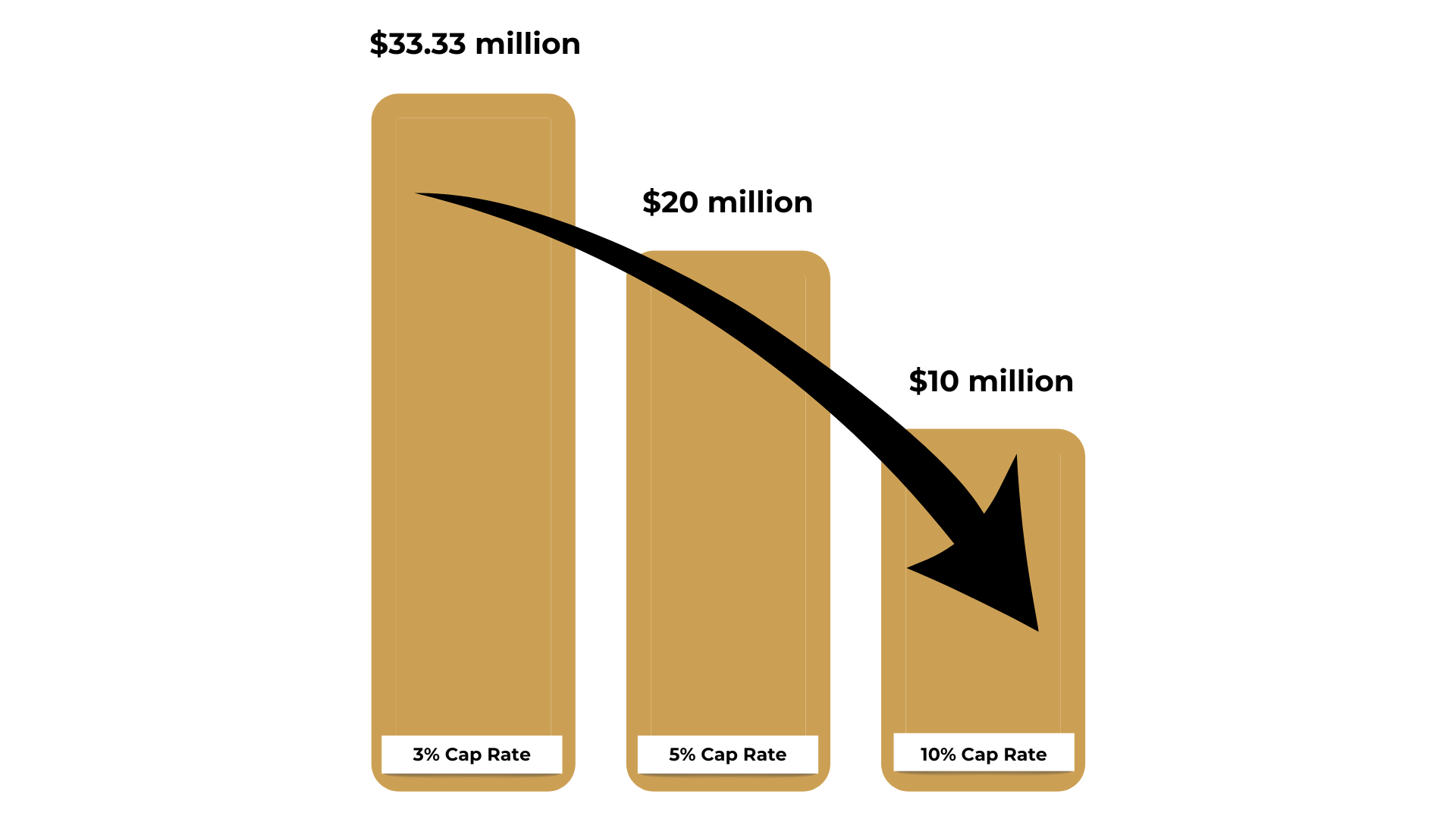
Multifamily Cap Rates
Multifamily cap rates are often correlated with risk. Properties that command high cap rates are typically perceived as riskier, perhaps due to less desirable locations or the need for substantial improvements. In contrast, newer and stabilized buildings usually feature lower cap rates.
For instance, multifamily buildings in New York City generally exhibit low single-digit cap rates due to high demand and the city’s robust economic environment, which translates to lower perceived risks.
However, properties with lower cap rates tend to have longer periods for investors to recoup their initial investments. Conversely, higher cap rates may allow investors to recover their costs more quickly from multifamily investments.
How to Calculate Cap Rates?
Cap rates are straightforward to calculate, making them an attractive metric for investors at all levels of experience. The cap rate is determined by dividing the net operating income (NOI) by the purchase price.

For example, a building generating an NOI of $650,000 annually, purchased for $15 million, would have a cap rate of 4.33% (calculated as $650,000 / $15 million).
Net Operating Income (NOI)
Given that cap rates are based on the income-to-price ratio, it is essential for investors to grasp how NOI is computed. NOI is derived by deducting all operating expenses from the gross income, which includes:
- All rental income.
- Ancillary revenues, such as from parking, storage lockers, and laundry services
Operating expenses encompass costs necessary to maintain and manage the property, including:
- Property taxes
- Insurance
- Utilities
- Management fees
- Regular repairs and maintenance
The income remaining after operating expenses is the property’s Net Operating Income.

It’s important to note that neither capital expenditures (CapEx) nor debt service are considered in the NOI calculation. This exclusion is primarily because both depend significantly on the investor’s strategy and business plan, which can vary greatly. For example, investors might choose to:
- Purchase the property outright with cash
- Employ significant leverage
- Undertake major property improvements
- Operate the property without any changes
Excluding these factors from the cap rate calculation allows for a more straightforward comparison of properties based on existing financial data, assuming no debt on the property. This method helps investors make more informed decisions by evaluating properties on a consistent financial basis.
Cap Rate Example
Consider an example to illustrate the typical use of a cap rate. Imagine we are analyzing the recent sale of a multifamily rental property.
Property Details:
Purchase price: $15,000,000
Gross rental income: $1,250,000
Operating costs: $250,000
Net operating income (NOI): $1,000,000
Using this information, the property sold at a cap rate of 6.67% (NOI of $1 million / Purchase price of $15 million).
Understanding the Cap Rate
The cap rate essentially indicates the percentage return an investor would expect to earn from an all-cash purchase of the property. In the example provided, an all-cash investment of $15,000,000 would yield an annual return on investment of 6.67%. This measure helps investors assess the risk and return profile of the investment compared to other opportunities in the market.
How to Assess Property Value Using Cap Rate?
Consider an example to illustrate the typical use of a cap rate. Imagine we are analyzing the recent sale of a multifamily rental property.
Cap rates are a valuable tool for investors to determine the value of a property.
For example, consider Class B apartments in Tampa, USA, which typically trade at a 5% cap rate. Suppose a broker provides you with financials showing a property’s Net Operating Income (NOI) is $400,000. Here’s how you can determine the property’s value using this cap rate:
Purchase Price Calculation:

Given the adjusted cap rate, this translates to : $400,000 / 5%= $8 𝑚𝑖𝑙𝑙𝑖𝑜𝑛
Why This Is Useful 💡
Imagine a property owner who wants to sell their property for $9 million. A potential buyer, using the cap rate calculation, can show that the property is worth around $8 million based on current market conditions. This calculation helps the buyer during negotiations, giving them a solid reason to argue for a lower price, rather than just saying, “I don’t think it’s worth that much.”
Even if the seller doesn’t drop their price, this information is still very useful for the buyer. It helps them assess their investment choices more clearly and provides a strong foundation for making decisions and comparing different properties.
Cap Rate vs. ROI
Cap rate and Return on Investment (ROI) are often confused, but they are distinct metrics used for evaluating real estate investments.
The cap rate is calculated without considering debt, based solely on the purchase price and the Net Operating Income (NOI). Conversely, ROI includes debt service and is calculated based on the equity invested, not the total purchase price.
ROI Calculation:

Where the Annual Return = NOI – Debt Service
Example:
Purchase Price: $20,000,000
Down Payment (Equity): $6,000,000
Net Operating Income: $800,000
Debt Service: $300,000
Annual Return: $500,000
Using the above details, the ROI would be:
$500,000 / $6,000,000 = 8.33%
Both cap rate and ROI provide valuable insights, and savvy investors typically use both metrics to analyze a real estate investment. ROI is an analytical tool that complements the cap rate by offering a deeper understanding of a deal’s profitability, considering the financing structure.
Factors Influencing Cap Rates in Multifamily Investing
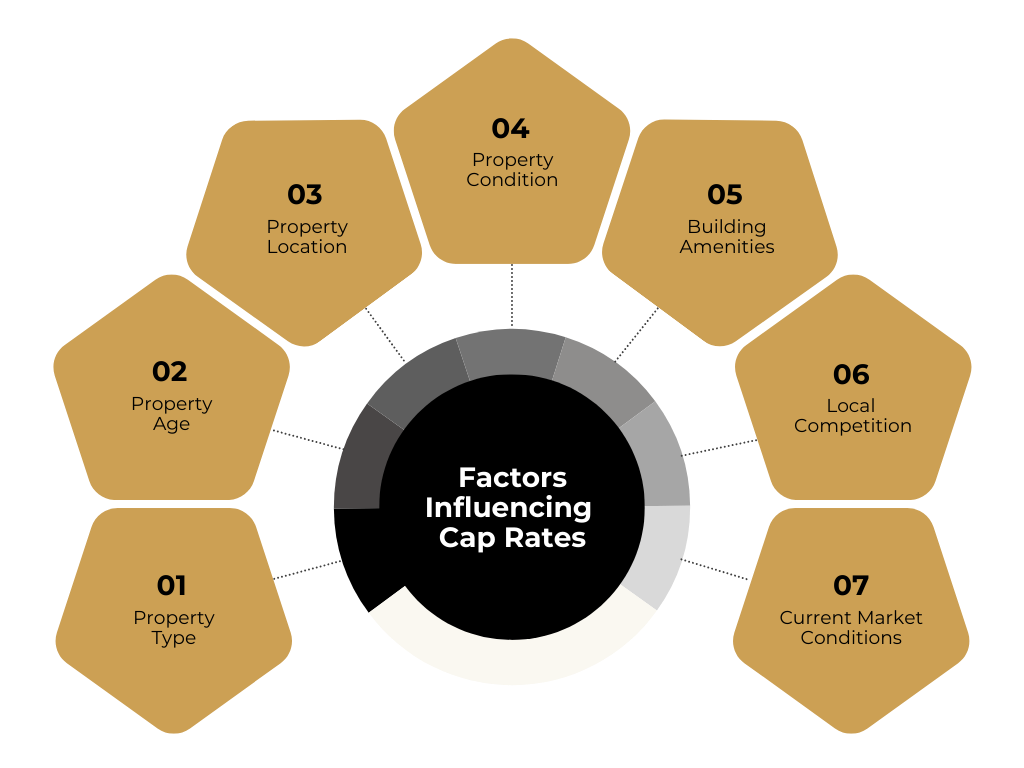
1. Property Type:
Cap rates differ by property type even within the same region. For instance, multifamily properties might have cap rates around 4-6%, whereas office spaces could see rates of 6-9%. Retail, hospitality and industrial properties also show variability in cap rates across different markets.
2. Property Age:
Older properties generally present lower cap rates due to potential physical deterioration and higher operational costs. The age may render some building features obsolete, complicating updates with modern amenities.
3. Property Location:
Location significantly influences cap rates. Properties in prime locations command higher market values and lower cap rates, whereas those in less desirable areas typically have higher cap rates. Within a metro area, urban properties usually have lower cap rates compared to suburban or rural locations.
4. Property Condition:
A property in good physical condition, especially one with sought-after amenities, tends to have a lower cap rate. Conversely, properties that require significant capital expenditures usually have higher cap rates.
5. Building Amenities:
Amenities can significantly affect a property’s cap rate. For example, an apartment with luxurious features like covered parking, a modern fitness center, a pool, and additional conveniences will likely command a lower cap rate compared to one without these amenities.
6. Local Competition:
The local competitive landscape is crucial. Existing properties, developments underway, and potential new developments due to favorable land costs and regulatory environments can all impact cap rates. For instance, if a new development emerges nearby, it may drive the cap rates higher for older properties unless they undergo value-adding improvements to stay competitive.
7. Current Market Conditions:
Market dynamics heavily influence cap rates. Factors such as investor sentiment, economic confidence, and interest rate environments are pivotal in shaping investment pursuits and cap rate evaluations.
Understanding these various factors can help investors make informed decisions when assessing the potential of multifamily investments.
Understanding Different Cap Rates in Multifamily Investments
Investors utilize several types of cap rates to evaluate multifamily properties:
- Going-in cap rate: This reflects the current value based on historical Net Operating Income (NOI).
- One-year-out cap rate: This is based on the projected NOI after a year.
- Exit cap rate: Critical for assessing a sponsor’s business plan, this rate anticipates the property’s value at the time of refinancing or selling.
It’s essential to understand that these rates can vary significantly. For instance, a going-in cap rate may differ greatly from the one-year-out or exit cap rate, especially if the property has undergone significant improvements or rent increases. Additionally, broader market shifts, like rising interest rates, can affect all cap rate calculations.
Cap Rates vs. Treasury Bills
Cap rates and Treasury bills are influenced by the broader economic environment, although in different ways.
Treasury bills are generally considered the safest investments, often setting the benchmark for risk-free returns. Investors use Treasury bill yields to gauge the relative attractiveness of riskier investments like real estate.
When Treasury bill yields are low, investors tend to seek higher returns from riskier investments, potentially driving down real estate cap rates as prices rise due to increased demand. On the other hand, when Treasury bill yields increase, the appeal of safer investments like Treasury bills grows, possibly leading to higher real estate cap rates as the demand for property decreases and investors demand higher returns to compensate for increased risk.
Changes in Treasury bill yields can significantly impact real estate valuations and investor behavior, making them a critical factor in investment analysis.
Research from Marcus & Millichap, from 1990 to 2023, illustrates the correlation between commercial real estate cap rates and the 10-year Treasury bond rate, highlighting how shifts in economic indicators influence investment decisions.
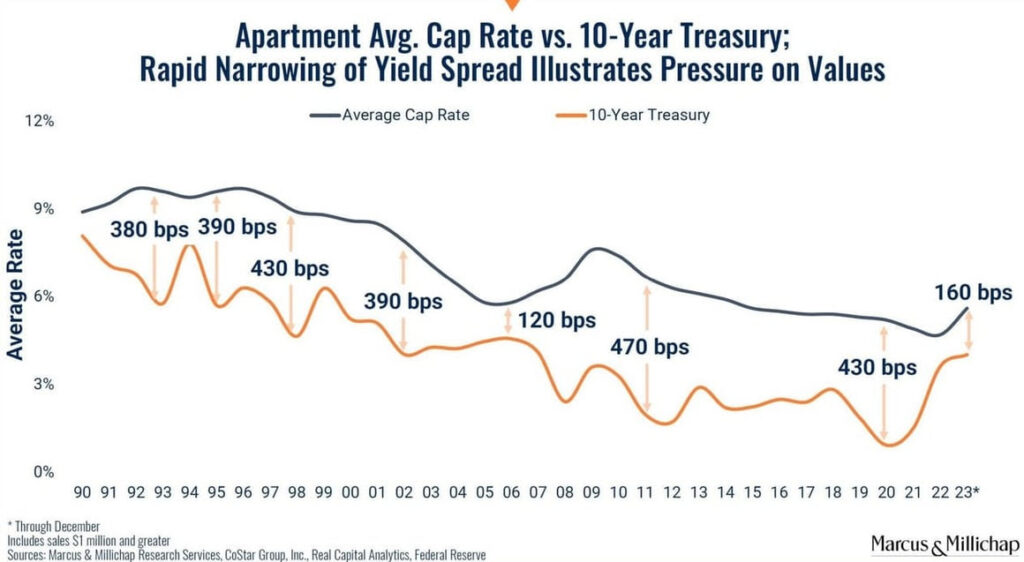
The multifamily cap rates versus the U.S. 10-year Treasury yield chart from Marcus & Millichap illustrates a near all-time low spread by the end of 2023. However, recent developments have seen the 10-year yield rise by about 70 basis points, while multifamily cap rates have held steady. This has resulted in the spread reaching a new record low of approximately 90 basis points.
What is a Good Cap Rate for Multifamily Properties?
Identifying a “good” cap rate for multifamily properties is subjective and varies significantly based on economic conditions and local market factors. In high-demand areas like New York, Miami, and Los Angeles, the average cap rate might be as low as 4% or even less.
Moody’s Analytics Structured Finance group uses CMBS data to track cap rate trends, noting that the cap rate spread in secondary markets was 100-200 basis points higher in the early part of the last decade. However, this spread has since narrowed to under 100 basis points across all markets.
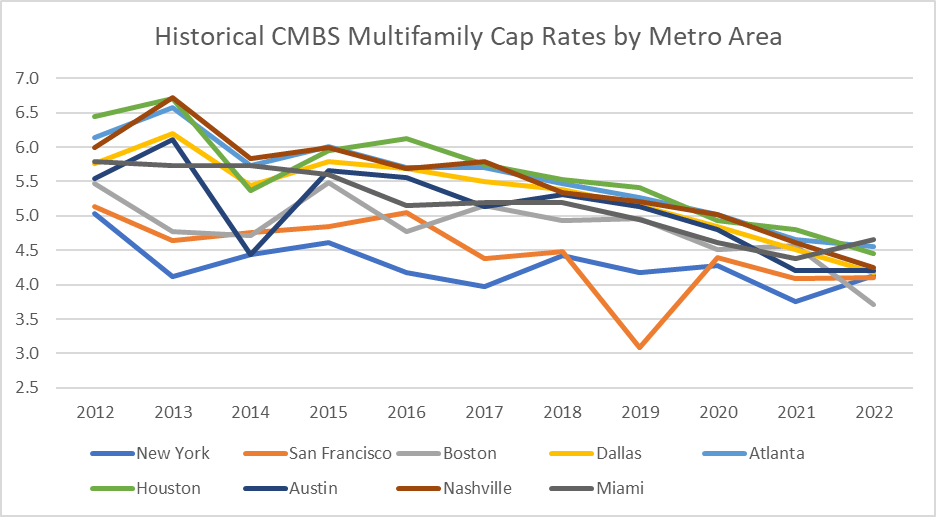
The quality of the building also affects cap rates; Class A properties generally have lower cap rates compared to Class B or C buildings. Generally, a “good” cap rate for multifamily properties ranges from 4% to 12%, depending on various factors.
Multifamily properties typically exhibit lower cap rates than other types of real estate investments, appealing broadly to investors who often pay a premium for these assets.
Conclusion
Cap rates are indispensable tools in real estate investment, offering a quick way to compare opportunities across different properties. They are crucial for investors analyzing not just multifamily properties but other types of real estate as well.
To effectively use this metric, investors should examine the factors influencing cap rates and consider the potential for NOI improvement. However, it’s also important to understand that some influencing factors, like overall market conditions, remain beyond an investor’s control.
For those new to commercial real estate investment or unsure about navigating metrics like the cap rate, partnering with a team of seasoned professionals can be beneficial.
Explore Opportunities with Faris Capital Partners. Are you an accredited investor looking to delve into apartment group investing in multifamily properties? Click here to arrange a discussion with our Investor Relations team and learn more.
Are you curious about what sets Faris Capital Partners apart? Download our information booklet to explore how we make it all possible and create value for our partners. Click here to access the booklet!
Ready to connect?
Book a call with our investor relations team today to learn more about current investment opportunities.
Have a question?
Please use the form below to contact us. We will never spam you, or sell your email to third parties.


